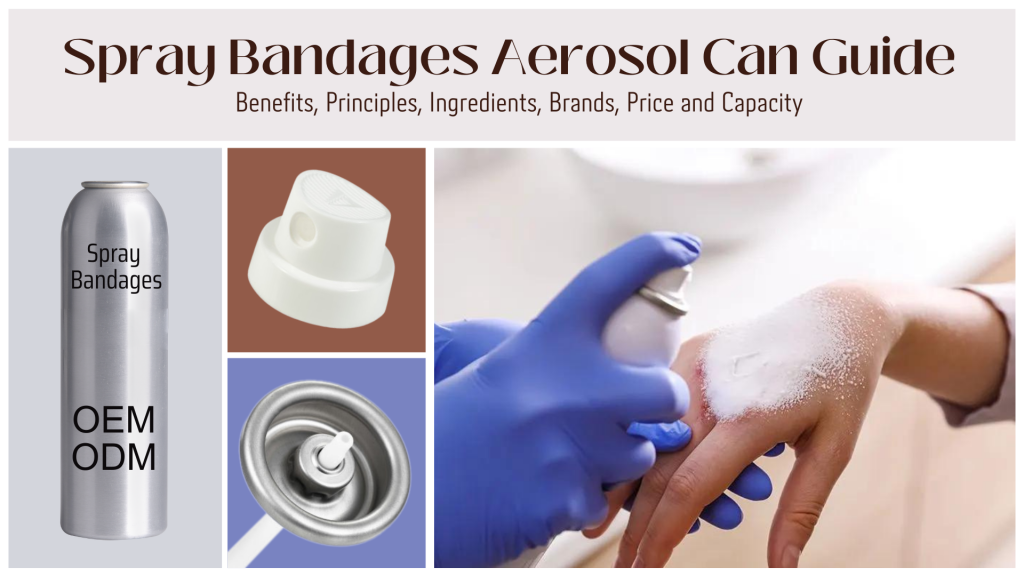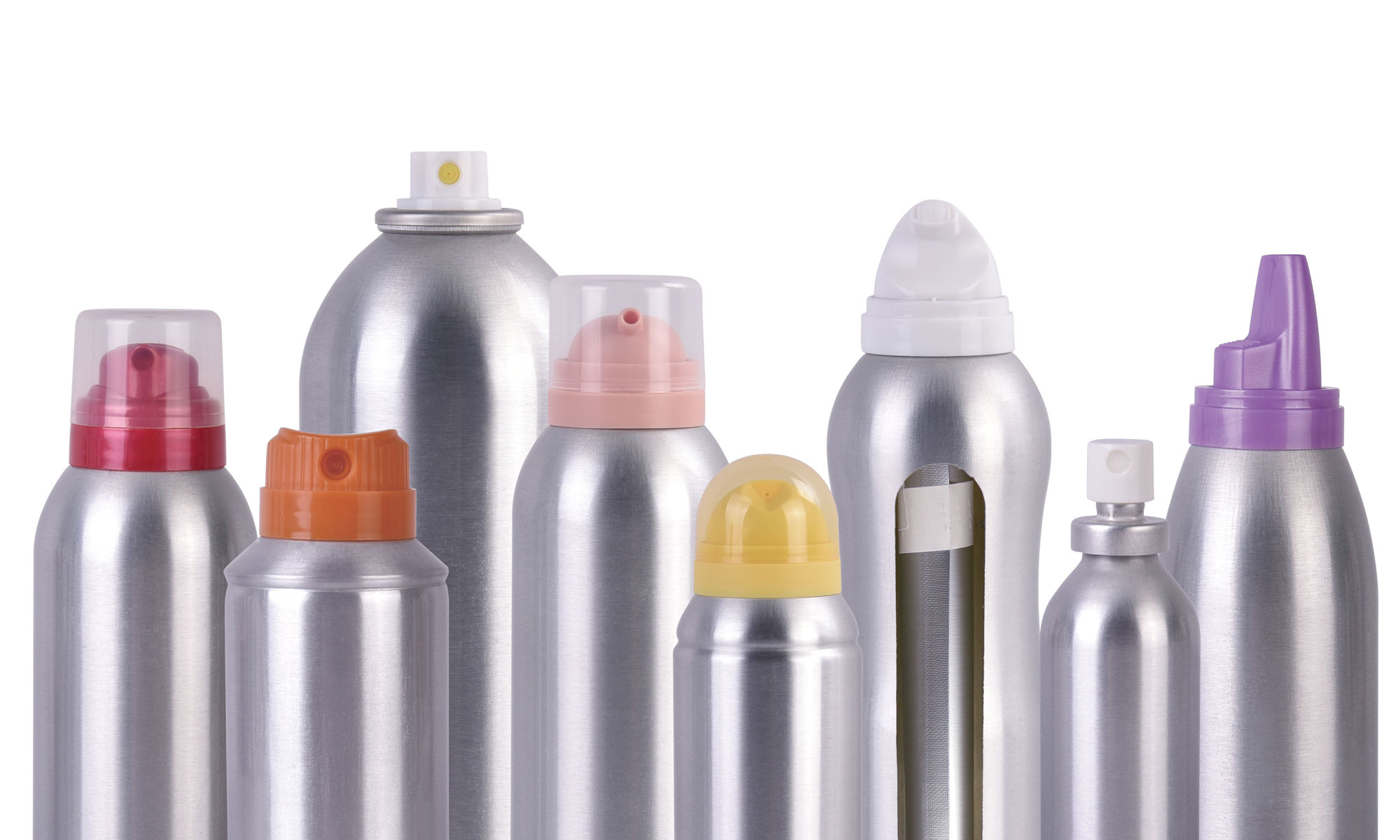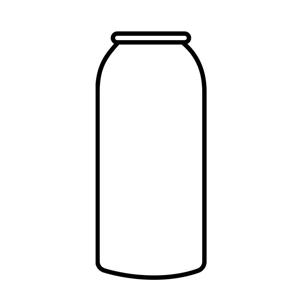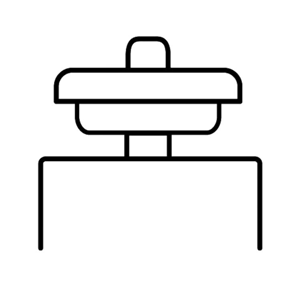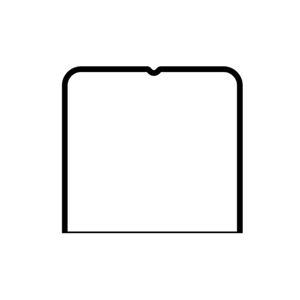Мировой рынок медицинских лент и бинтов, включая спрей-бинты, оценивался в 7,79 млрд долларов США в 2023 году. Прогнозируется, что он будет расти с годовым темпом прироста (CAGR) 3,4% с 2024 по 2030 год. Этот рост обусловлен ростом числа раневых инфекций, дорожно-транспортных происшествий и возросшими опасениями по поводу безопасности пациентов. Комплексный анализ рынка, предоставленный Гранд Вью Исследования подчеркивает эти тенденции и важную роль технологических достижений в развитии рынка.
Поскольку мы углубляемся в особенности аэрозольных повязок, это руководство будет охватывать многочисленные преимущества, основные принципы, ключевые ингредиенты, ведущие бренды, цены и емкость этих инновационных продуктов. Аэрозольные повязки предлагают удобное, гигиеничное и эффективное решение для небольших ран и ссадин, что делает их необходимым предметом в аптечках первой помощи. Понимание различных аспектов аэрозольных повязок может помочь потребителям принимать обоснованные решения относительно вариантов ухода за ранами.
Что такое аэрозольные повязки?
Я считаю, что аэрозольные повязки невероятно удобны для ухода за ранами. Они выпускаются в аэрозольных баллончиках, что делает их более простыми в использовании по сравнению с традиционными повязками, которые необходимо наносить непосредственно на кожу. Когда я распыляю повязку на рану, она образует защитную пленку, которая действует как барьер против грязи, бактерий и других загрязняющих веществ. Это помогает поддерживать чистоту раны и способствует ее заживлению, давая мне душевное спокойствие, зная, что моя рана защищена.
Что я особенно ценю в аэрозольных повязках, так это их универсальность. Их можно накладывать на раны разных форм и размеров, в том числе в труднодоступных местах. Защитная пленка воздухопроницаема, что позволяет воздуху циркулировать вокруг раны, что способствует более быстрому заживлению. Кроме того, многие аэрозольные повязки водонепроницаемы, поэтому мне не нужно беспокоиться о том, что они снимутся, когда я умываюсь или принимаю душ. Включение антимикробных агентов в некоторые составы еще больше усиливает их способность предотвращать инфекцию, что делает их незаменимым предметом в моей аптечке.
Каким образом аэрозольные повязки создают защитный барьер?
Спрей-бинты работают, используя мелкодисперсный туман жидкости, который при распылении на рану быстро образует тонкую защитную пленку. Эта пленка действует как барьер против внешних загрязнителей, таких как грязь и бактерии, помогая предотвратить инфекцию. Процесс нанесения прост: пользователь держит аэрозольный баллончик на расстоянии нескольких дюймов от раны и равномерно распыляет. Через несколько секунд жидкость высыхает, образуя гибкий водонепроницаемый слой, который прилипает к коже. Этот слой воздухопроницаемый, что позволяет кислороду достигать раны, что имеет решающее значение для процесса заживления.
В состав спрей-бинтов обычно входят пленкообразующие вещества, такие как акрилаты и этиловый спирт в качестве растворителя, что помогает пленке быстро высыхать. Некоторые составы также включают противомикробные вещества для дополнительной защиты от инфекции. Удобство спрей-бинтов заключается в их способности покрывать раны различных форм и размеров, в том числе в труднодоступных местах. Кроме того, поскольку они не содержат клейких материалов, существует меньший риск раздражения кожи, что делает их подходящими для чувствительной кожи и для использования на суставах и других часто подвижных участках.
Основные ингредиенты в аэрозольных пластырях
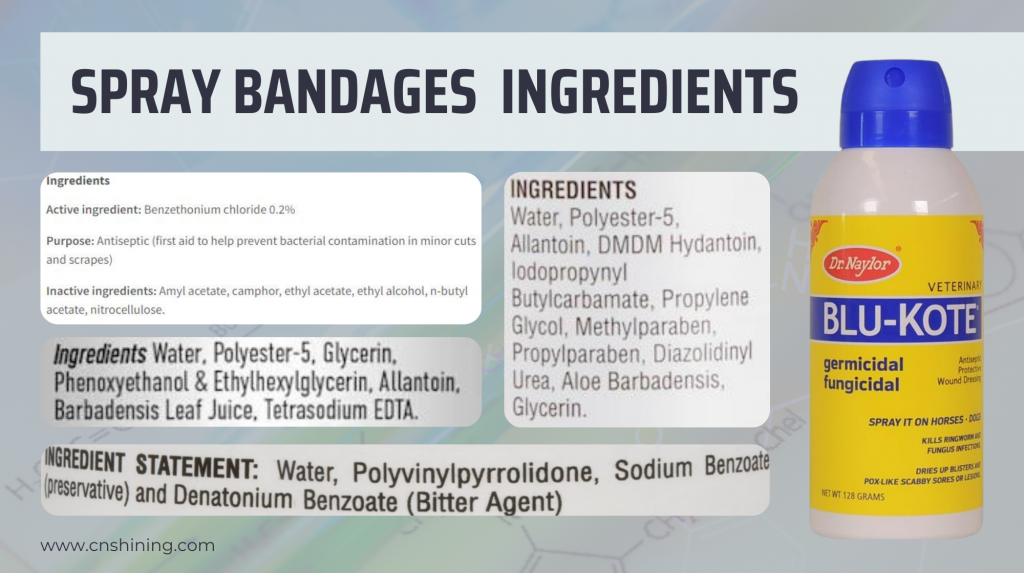
Мы исследовали несколько самых продаваемых аэрозольных бинтов на Amazon и определили следующие общие ключевые ингредиенты. Понимание назначения и роли каждого компонента может помочь вам принять обоснованное решение о продуктах, которые вы используете для небольших порезов и царапин.
Ключевые ингредиенты и их роль
1. Бензетония хлорид (0,2%):
Этот активный ингредиент служит антисептиком. Его основная функция — предотвращение бактериального заражения в небольших порезах и царапинах, гарантируя чистоту раны и снижая риск заражения.
2. Неактивные ингредиенты:
Амилацетат: часто используется в качестве ароматизатора, в этом контексте он может быть частью рецептуры для придания приятного аромата.
Камфора: известная своими противовоспалительными свойствами, камфора также может вызывать ощущение прохлады при нанесении на кожу.
Этилацетат и н-бутилацетат: эти растворители способствуют быстрому высыханию спрея на коже, образуя защитный слой.
Этиловый спирт: действует как дополнительный антисептик, а также способствует процессу испарения.
Нитроцеллюлоза: пленкообразующий агент, помогающий создать защитный слой на ране.
3. Дополнительные ингредиенты:
Вода: используется в качестве растворителя и основы для рецептуры.
Полиэстер-5: пленкообразующий агент, который создает на коже эластичный защитный слой.
Глицерин: увлажнитель, помогающий сохранять кожу увлажненной.
Феноксиэтанол и этилгексилглицерин: консерванты, предотвращающие рост бактерий и плесени в продукте.
Аллантоин: известен своими успокаивающими и целебными свойствами.
Сок листьев барбадосского дерева (алоэ вера): оказывает увлажняющее и успокаивающее действие на кожу.
Тетранатриевая соль ЭДТА: хелатирующий агент, помогающий поддерживать стабильность и эффективность продукта.
DMDM гидантоин, йодопропинил бутилкарбамат, пропиленгликоль, метилпарабен, пропилпарабен, диазолидинил мочевина: консерванты и стабилизаторы, которые обеспечивают сохранение эффективности продукта и отсутствие загрязнений.
Поливинилпирролидон: пленкообразующий агент, усиливающий адгезивные свойства повязочного спрея.
Бензоат натрия: консервант, помогающий предотвратить рост микроорганизмов.
Бензоат денатония: горькое вещество, препятствующее случайному проглатыванию.
Если вы все еще не понимаете ингредиенты, упомянутые выше, или если вам нужно настроить свой собственный аэрозольный баллон Spray Bandages, пожалуйста, свяжитесь с нами. Мы специализируемся на производстве аэрозольных баллонов Spray Bandages, а также предлагаем услуги по наполнению готовой продукции. Не стесняйтесь обращаться к нам!
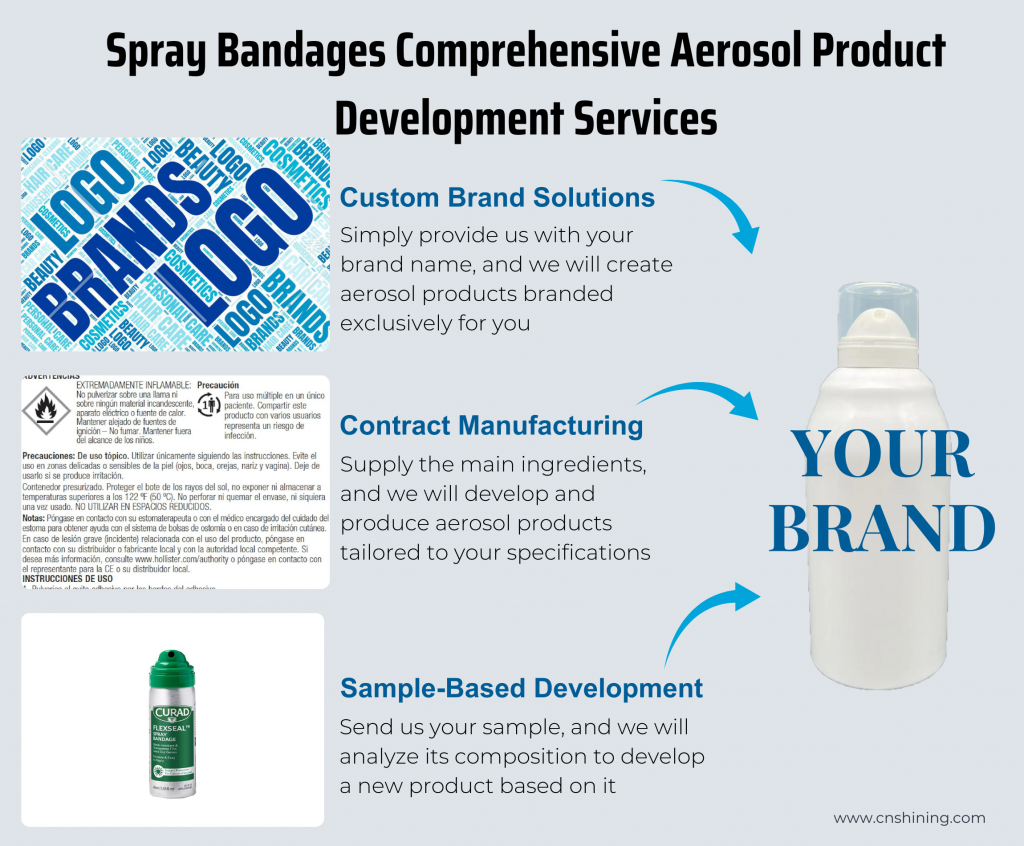
Лучшие аэрозольные повязки для быстрого и эффективного лечения ран
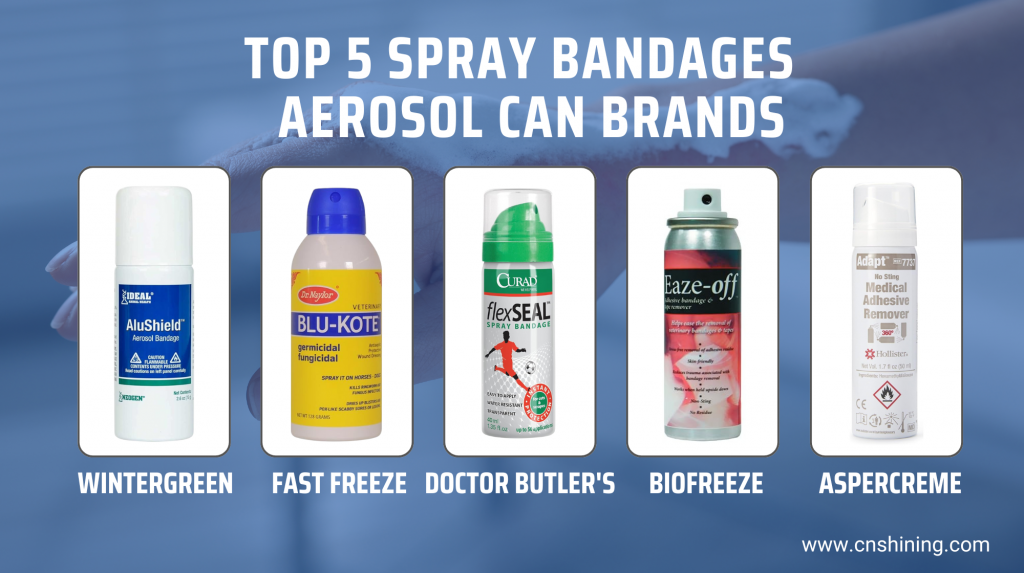
Мы оценили несколько самых продаваемых аэрозольных продуктов Spray Bandages на основе узнаваемости бренда, эффективности продукта и отзывов клиентов. Вот пять лучших брендов, а также их преимущества и особенности продукта:
Курад
- Преимущества бренда: Curad, известный своим широким ассортиментом товаров первой помощи, имеет прочную репутацию благодаря качеству и надежности.
- Характеристики продукта: Пластырь Curad Flex Seal Spray Bandage обеспечивает мгновенное покрытие для небольших порезов и царапин. Он имеет водостойкую и прозрачную пленку, которая блокирует грязь и микробы, способствуя оптимальному заживлению ран. Он также портативен и удобен для использования на ходу.
Доктор Нейлор
- Преимущества бренда: Dr. Naylor славится своими решениями в области ветеринарии и оказания первой помощи, которым профессионалы доверяют уже десятилетиями.
- Характеристики продукта: Спрей-бинт доктора Нейлора обладает превосходными защитными свойствами, образуя прочный барьер над ранами. Он прост в применении и идеально подходит как для людей, так и для животных, обеспечивая универсальное использование для различных нужд.
Холлистер Адапт
- Преимущества бренда: Hollister — это хорошо зарекомендовавший себя бренд на рынке медицинских принадлежностей, известный инновационной и высококачественной продукцией.
- Характеристики продукта: Повязка-спрей Hollister Adapt Spray Bandage особенно ценится за ее нежную формулу, которая подходит для чувствительной кожи. Она образует гибкий, дышащий слой, который защищает рану, не стесняя движений и обеспечивая комфорт.
Неоген
- Преимущества бренда: Neogen известен своими передовыми биотехнологическими решениями, особенно в области ухода за животными.
- Характеристики продукта: Аэрозольный бинт AluShield от Neogen выделяется своей простотой и эффективностью. Он образует водостойкий барьер, который защищает раны от загрязнений без использования антибиотиков, что делает его пригодным для животных и полезным в различных средах.
Джасинбер
- Преимущества бренда: Jasinber набирает популярность благодаря своим доступным, но эффективным решениям для оказания первой помощи.
- Характеристики продукта: Распыляемые бинты Jasinber обеспечивают быстросохнущую и гибкую защиту от небольших порезов и ссадин. Их хвалят за их экономичность и простоту использования, что делает их хорошим выбором для домашних аптечек первой помощи.
Ценовая разбивка аэрозольных бинтов
На основе анализа продуктов Spray Bandages Aerosol, доступных на Amazon, цены показывают широкий разброс. Вот подробная разбивка:
0-9.9$: В этом диапазоне 11 продуктов, что составляет 24% от общего числа. Это говорит о том, что значительная часть спрей-бинтов доступна по очень доступной цене, что делает их доступными для широкой аудитории.
10-14.9$: С 10 продуктами этот диапазон представляет 22% рынка. Эти продукты среднего ценового диапазона, вероятно, предлагают баланс между стоимостью и качеством, привлекая потребителей, ищущих хорошую ценность.
15-19.9$: В этой категории 9 продуктов, составляющих 20% рынка. Продукты в этом диапазоне могут предлагать дополнительные функции или улучшенные формулы, привлекая потребителей, которые готовы потратить немного больше за улучшенные преимущества.
20-24.9$: Этот ассортимент включает 7 продуктов, представляющих 16% рынка. Эти продукты могут позиционироваться как премиальные варианты с превосходными ингредиентами или упаковкой.
25–29,9$: В эту линейку входят 4 продукта (9%), в том числе продукты более высокого класса, возможно, со специализированными функциями или от известных брендов.
30-34.9$: Только 1 продукт попадает в эту категорию, что составляет 2%. Это говорит о том, что очень немногие продукты имеют цену в этом более высоком диапазоне, что может указывать на нишевый рынок.
35-40$: Этот диапазон включает 3 продукта, что составляет 7% от общего числа. Это, вероятно, самые дорогие доступные варианты, возможно, предлагающие наилучшую производительность или самые большие количества.
Из этого анализа очевидно, что большинство спрей-бинтов имеют цену ниже $20, что делает их доступными для большинства потребителей. Однако есть также премиум-варианты для тех, кто ищет особые характеристики или более высокое качество.
Анализ рынка: Распределение аэрозольной емкости аэрозольных бинтов
На основе таблицы, показывающей распределение объемов аэрозольных спреев-бинтов на Amazon, я заметил несколько ключевых тенденций:
1,0 унция (29,57 мл): эта емкость является наиболее распространенной, и 45% продуктов попадают в эту категорию. Это говорит о том, что размер в 1 унцию является весьма предпочтительным, вероятно, из-за его удобства для личного использования и достаточного объема для многократного применения.
0,61 унции (18,04 мл): с 25% продуктов эта емкость также довольно популярна. Это указывает на значительное предпочтение рынка в пользу меньших, более портативных вариантов, возможно, для использования на ходу.
1,35 унции (39,92 мл и 40,0 мл): вместе они представляют 15% продуктов. Небольшое различие в измерении мл показывает, что разные бренды могут по-разному маркировать схожие емкости, но этот размер обычно считается вариантом среднего диапазона.
3,0 унции (88,72 мл): эта большая емкость составляет 5% продуктов. Это предполагает нишевый рынок для потребителей, которым требуется больше продукта для интенсивного использования или больших площадей.
2,6 унции (76,89 мл): Подобно 3,0 унциям, этот размер также занимает 5% на рынке, что является еще одним вариантом для тех, кому нужен больший объем.
0,5 унции (14,79 мл): эта наименьшая емкость также составляет 5% продуктов. Это указывает на сегмент рынка, который предпочитает очень компактные и портативные решения.
Из этого анализа становится ясно, что на рынке доминирует размер 1,0 унции, за ним следует размер 0,61 унции. Эти размеры, вероятно, предлагают баланс между удобством и объемом, удовлетворяя потребности большинства потребителей.
На основе указанных выше мощностей мы составили список распространенных размеров аэрозольных баллончиков Spray Bandages. Вы можете обратиться к таблице ниже, чтобы заказать алюминиевые аэрозольные баллончики желаемой мощности.
| Диаметр | Длина | Жидкий газ | Жидкий газ | Сжатый газ(БОВ) | Полная мощность |
| мм | мм | мл | унция | мл | мл |
| 35 | 65 | 40 | 1.35 | 30 | 55 |
| 35 | 88 | 50 | 1.69 | 75 | |
| 35 | 125 | 75 | 2.53 | 110 | |
| 35 | 156 | 100 | 3.38 | 75 | 140 |
| 38 | 110 | 75 | 2.53 | 110 | |
| 40 | 100 | 75 | 2.53 | 110 | |
| 40 | 110 | 75 | 2.53 | 110 | |
| 40 | 138 | 100 | 3.38 | 75 | 140 |
| 45 | 105 | 100 | 3.38 | 75 | 140 |
Заключение:
В этой статье рассматриваются принципы, ингредиенты бренда, цены и емкость Spray Bandages. Как профессиональный производитель алюминиевых аэрозольных баллонов, мы производим пустые 40 мл, 77 мл и 89 мл алюминиевые аэрозольные баллончики и предоставить полный набор клапанов и приводов. Если вам требуются услуги по заполнению, мы также предлагаем услуги по заполнению OEM. У нас есть собственные формулы и мы можем разработать новые на основе ваших спецификаций.
Наша компания может похвастаться 30-дневным сроком поставки продукции и 35-летним опытом производства алюминиевых банок. Для американского рынка наша продукция сертифицирована по стандартам US DOT 2P и 2Q. Свяжитесь с нами сейчас, чтобы узнать больше о деталях упаковки Spray Bandages.

















